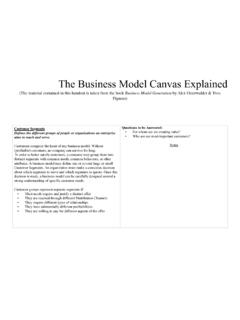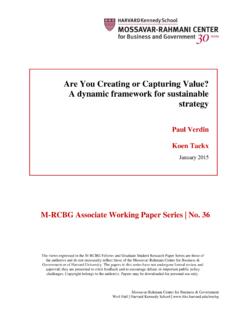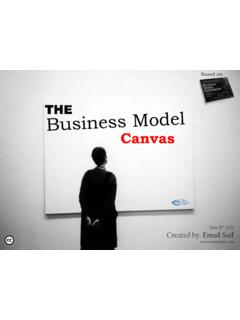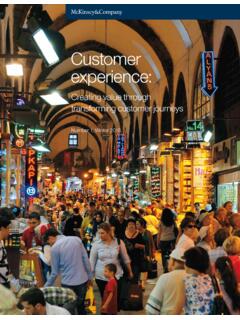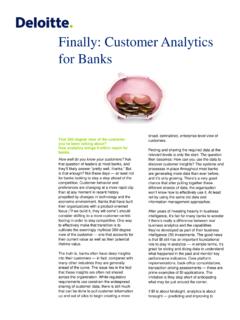Transcription of Case study McDonalds
1 Erasmus Platform for Sustainable value Creation Case study McDonald's Willem Schramade McDonald's: a sustainable finance case study September 2019 Willem Schramade Erasmus Platform for Sustainable value CreationImportant: this company analysis was done for educational purposes. It is not an investment recommendation nor does it in any way reflect the opinion of RSM, Erasmus University. Target prices were calculated only to illustrate ways of thinking about value . | Erasmus Platform for Sustainable value Creation3 Abstract4 Introduction5 The list of questions6 Answering the questions for McDonald's9 Conclusions and reflections27 References28 Important: this company analysis was done for educational purposes.
2 It is not an investment recommendation nor does it in any way reflect the opinion of RSM, Erasmus University. Target prices were calculated only to illustrate ways of thinking about is the third in a series of RSM case studies on sustainable finance. Using a list 1of questions, we show how to integrate sustainability into investment analysis by connecting sustainability to business models, competitive position, strategy and value drivers. Here the questions are answered for McDonald s, a company that faces substantial sustainability challenges, on both the social (health) and environmental (footprint) dimensions.
3 Our findings suggest that McDonald s is not as well positioned as Philips, but much better than Air France-KLM. Unlike the latter, McDonald s does have significant options to deal with its sustainability issues. However, our ability to properly assess its transition preparedness is hampered due to the absence of essential data: McDonald s sustainability reporting is limited and lacks targets and numbers. Unfortunately, this is typical of current reporting practices. 1 Abstract After Philips ( ) and Air France-KLM ( ) | Erasmus Platform for Sustainable value Creation4In this case study we analyse McDonald s, a company that faces substantial sustainability headwinds.
4 We chose McDonald s because it highlights the predicament of a company that performs very well financially as long as its negative externalities are not internalized. Like the other cases in this series (on Philips and Air France-KLM), it presents a list of questions that allow analysts to integrate sustainability into investment analysis by connecting sustainability to business models, competitive position, strategy and value drivers. Our finding suggest that McDonald s is not as well positioned as Philips to meet its sustainability challenges. Like Air France-KLM, McDonald s faces serious sustainability challenges both on the social (health) and environmental (carbon footprint) side.
5 However, its odds of overcoming these headwinds look much better than at Air France-KLM: McDonald s is more profitable, more advanced in terms of sustainability reporting and thinking, and it has significant options to deal with these issues. For example, the company has taken initiatives to make its food healthier but encountered lukewarm consumer response; and its supply chain initiatives look promising, be it with the suspicion of green washing. However, it needs to be emphasized that essential data is missing as McDonald s sustainability reporting is limited and lacks targets and numbers.
6 This puts a large question mark on the company s transition preparedness. Investor engagement could alleviate this problem. Like the other cases in this series, this one highlights the need for fundamental analysis (that is, going well beyond ESG ratings) to properly assess a company s transition preparedness, which we deem the essence of corporate sustainability. This article is set up as follows: in the next section, the list of questions is presented. In the subsequent section, the questions are answered for McDonald s, starting with the company s business model and value drivers, before diving into strategy and sustainability.
7 It then goes back to the value drivers and the investment case to see how they have been affected by the sustainability analysis. In this way, the analyst develops a holistic view of the company. The final section concludes and reflects. 2 Introduction | Erasmus Platform for Sustainable value Creation5 The below list of questions (Table 1) has been made over the course of several years of doing ESG integrated investment analysis, and is exactly the same as in the Philips case. More recently, they have been structured as an assignment for the Sustainable Finance course taught at Erasmus University and can be found in our Sustainable Finance textbook (Schoenmaker and Schramade, 2019, Chapter 8).
8 They are meant to deepen students and practitioners understanding of ESG integration by having them apply sustainable finance insights to a real life example and ideally discuss with fellow students or colleagues. They are 25 questions (even more including sub-questions) in six sections. Although the six sections address different issues, it should become obvious during the analysis that they are very much related. TABLE 1 LIST OF SUSTAINABLE FINANCE QUESTIONS FOR ESG INTEGRATION 3 The list of questionsSectionQuestions1. Business model & competitive would you describe the company s business model?
9 Strong do you rate the company s competitive position? trends affect the company s business model and competitive position?2. value drivers (part 1) growth: what seems to be a normal sales growth for the company? And what are the drivers of sales growth? : what seems to be a normal profit margin (EBIT or EBITDA) for the company? And what are the drivers of that margin? : how capital intense is the company? What do you think is the firm's cost of capital? What is the firm's return on invested capital (ROIC) sketch how you see the company s value drivers going forward?
10 | Erasmus Platform for Sustainable value Creation63. : what is the company's mission / purpose / raison d' tre? In what way does the company create value for society? How does it get paid for that value creation? : what are the company's main stakeholders? Please fill out the stakeholder impact tool & impact: Does the company generate serious externalities? Are they positive or negative? How do you assess the chances of these externalities to be internalized? Thresholds: how does the company perform versus the planetary boundaries? : which of the SDGs (if any) does the company help achieve?
